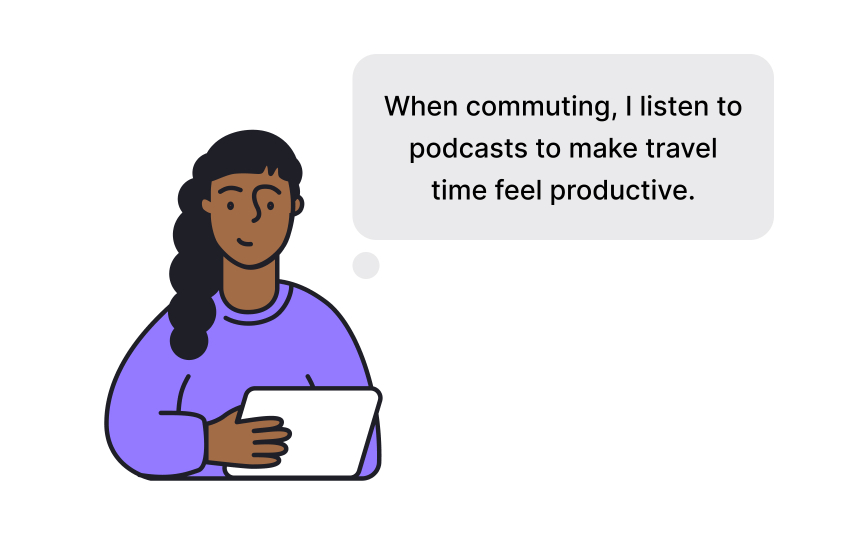Defining Target Audience
Define who your product is for by segmenting markets and creating clear customer personas.
Many products fail not because they were poorly built but because they were built for the wrong people. Defining a target audience is about narrowing focus to those who truly need and value what you create. Without this clarity, even a well-designed product risks drifting in the market with no clear fit.
Segmentation provides a starting point. By dividing a broad market into groups based on factors such as age, habits, location, or motivations, teams uncover meaningful differences in needs and behavior. These patterns reveal where the strongest opportunities lie. Psychographic insights, for example, often explain why two customers of the same age may react very differently to the same product.
Personas bring those segments to life. Instead of designing for abstract data points, teams design for people with recognizable goals, frustrations, and contexts. A persona can shift a conversation from “users want this feature” to “Anna, a busy parent, needs a faster checkout flow.” This level of empathy helps teams align product choices with real situations.
A well-defined target audience becomes more than a marketing exercise. It guides product design, shapes communication style, and influences long-term growth strategy. With the right audience in mind, every decision, from features to pricing, connects to people who are most likely to adopt and champion the product.
A target market is the group of people most likely to purchase and use a product or service. These individuals share characteristics that influence how they make buying decisions, such as age, location, income, or lifestyle. Identifying this group is essential because no company has the resources to appeal to everyone at once.
Defining a target market requires research into who has the strongest need for the product and the ability to access it. Without this focus, even well-designed products can miss the mark and fail to gain traction. A company offering plant-based protein snacks, for instance, will have greater success if it concentrates on health-conscious consumers and people following vegan or vegetarian diets, rather than
By clearly defining a target market, businesses can shape product features,
The terms “target market” and “target audience” are often confused, but they describe different levels of focus. A target market is the broader group of people most likely to purchase a product or service. It is defined by shared characteristics such as age, location, or income, and it represents the main customer base that sustains a business.
The target audience is narrower. It refers to the specific segment within that market that a company wants to reach with a particular campaign or product release. For example, an athletic brand may serve a broad target market of adults interested in fitness, but a campaign for trail-running shoes may focus on outdoor runners aged 20–35.
Recognizing the difference between these terms helps businesses avoid spreading their efforts too thin. The target market informs long-term strategy and product design, while the target audience helps create precise, relevant messages for
Demographic data is one of the most common tools for defining a target market because it provides measurable characteristics of potential customers. These characteristics include:
- Age
- Gender
- Income
- Education level
- Marital status
- Occupation
By analyzing these characteristics, businesses can identify patterns that influence how people make buying decisions.
For instance, families with young children may respond positively to products that emphasize safety and convenience, while single professionals with higher incomes may be more interested in premium quality or innovation. Geographic information is also part of demographics, since location shapes access to products and cultural expectations.
Although demographics are helpful in narrowing down a market, they are not complete on their own. Two people with similar demographic traits may still make very different choices. This is why demographics are often used as a starting point, then combined with psychographic and behavioral data. When treated as one part of a broader analysis, demographics provide a clear framework for grouping customers into meaningful segments.
Psychographics go beyond basic demographics by looking at values, attitudes, interests, and lifestyles. While demographics tell you who your customers are, psychographics explain why they make choices. For example, two people with the same age and income may act very differently if one values sustainability while the other prioritizes convenience.
Businesses use psychographic insights to align products with customer motivations. A
By adding this layer of understanding, companies can develop products and campaigns that feel more personal and meaningful. Psychographics uncover the emotional drivers behind decisions, helping teams predict not just what customers can buy, but what they truly want to buy.
Behavioral segmentation groups customers by how they act, not just who they are. It includes habits such as purchase frequency,
Sources often highlight categories such as:
- Loyalty‑based (repeat buyers)
- Usage‑based (heavy or light users)
- Benefit‑based (what customers value)
- Occasion‑based (special time or event purchases)
- Needs‑based segments[3]
These types bring clarity to how different groups interact with the product.
To detect behavioral patterns effectively, companies can use tools like:
- Cohort analysis: tracking user groups over time to spot trends
- Session recordings: showing where users click, scroll, or get stuck[4]
Analyzing purchase history helps spot peak usage times or product combos that often sell together, and split testing (A/B) reveals which actions yield higher engagement.
Together, these methods give teams real, actionable insights. They show where users drop off, so pain points can be smoothed. They show which segments engage most, so promotions can be tailored. In practice, this clarity improves retention, satisfaction, and revenue.
Creating audience profiles means giving life to segments by combining traits, behaviors, and motivations into detailed, realistic representations. Begin by selecting one key segment, for instance, budget-conscious professionals who shop late evenings, and summarize their typical day, needs, and frustrations.
Enrich the profile with data: use CRM or support logs to capture the real language customers use when describing problems. Add insights from surveys or social media that reveal their motivations or values. Include specific cues that influence decisions, such as seeking fast delivery or trusting certain endorsements.
These profiles should be clear enough for teams to use during planning: ask questions like, “Does this feature reduce friction for this profile?” or “Does our message resonate with them?” The profiles bring data to life, making product strategy more empathetic and precise.[5]
To create useful personas, collect evidence from interviews, surveys, analytics, and support tickets. Look for recurring patterns and distill them into a persona that includes a short background, primary goals, frustrations, and decision-making factors. Give the persona a name and a brief story to make it memorable. For example, “Leila, 29, fitness coach, values quick digital solutions that save time” is easier to design for than abstract statistics.
Personas are most effective when they stay grounded in data but are human enough to inspire
The Jobs to Be Done framework shifts attention from who the customer is to what they are trying to achieve. Instead of focusing only on demographics or
For example, commuters may “hire” a podcast app not only for entertainment but also to make their travel time feel productive. A family may “hire” a meal kit service to reduce stress at dinner, not just to try new recipes. Framing needs in this way helps teams identify functional, emotional, and social dimensions of customer behavior.[7]
By asking questions like “What progress is the customer seeking?” or “What obstacles block them?” teams uncover motivations that drive adoption. JTBD works best when combined with personas and
A clear audience definition is not an isolated step; it underpins the entire product strategy. Once you know who you serve and why, every choice, from features to
Audience insights also influence channel selection and communication style.
By embedding the target audience into strategic decisions, teams avoid building in isolation. Instead, they create products and services that feel relevant, timely, and valuable to the people most likely to adopt them.[9]
References
- User Behavior Patterns: 8 Examples & How to Analyze Them | Thoughts about Product Adoption, User Onboarding and Good UX | Userpilot Blog
- Jobs-to-be-Done | Strategyn
- Know Your Customers’ “Jobs to Be Done” | Harvard Business Review





















